What Color Do U Get if U Mix Pink and Blue
This post may contain affiliate links. We may earn a small commission from purchases made through them, at no additional cost to you.
The color blue is a primary color and is a dominant color. Blue is often used by painters and appears on the palette more frequently than many other colors. Therefore, you will do well to learn more about mixing different shades of blue and expand on your ability to blend colors. In this article, we will be helping you better understand what colors make blue.
Table of Contents
- 1 What Color Makes Blue?
- 1.1 What Colors Make Light Blue Paint?
- 1.2 What Colors Make Cyan Paint?
- 1.3 What Color Does Blue and Green Make?
- 1.4 How to Make Different Dark Blue Hues?
- 1.5 Creating Muted Shades of Blue
- 1.6 How to Create Warm Shades of Blue?
- 1.7 How to Create Turquoise Blue Colors?
- 2 Psychology of the Color Blue
- 3 Differences between Various Shades of Blue
- 4 What Colors Make Dark Blue Paint?
- 4.1 Making Dark Blue Color by Adding Black Paint
- 4.2 Making Dark Blue Color by Adding Complementary Paint Colors
- 4.3 Making Dark Blue Color by Adding Analogous Paint Colors
- 5 Tips When Mixing Different Shades of Blue
- 6 Conclusion
- 7 Frequently Asked Questions
- 7.1 What Color Will Dark Forest and Ocean Blue Make?
- 7.2 Can I make Green without Using Blue?
- 7.3 To Make Dark Blue Paint, Can I add Black or Combine Other Colors?
- 7.4 How to Make Blue Paint with Orange?
- 7.5 When Blending Black with Ice Blue What Color Will I Create?
- 7.6 How to Make Blue Lighter?
- 7.7 What Color Can I use with Brilliant Blue to Make Dark Sea Blue?
What Color Makes Blue?
There are many shades, hues, and tints of blue, for example, dark blue, light blue, muted blues, and warm blues. The list can go on and on, which is why we are here to help you learn what two colors make blue and how to create various shades of blue. At this stage, you may be asking the question what two colors make blue? The answer to what color makes blue is none, as blue is a primary color so there is no need to mix any two colors to make blue. However, there are two colors that you can mix to make blue. Once you have created your true blue color, then you can begin creating any blue hue that you can imagine.

So, what are the two colors you can mix to make blue? Mix cyan (greenish-blue) with magenta (purplish-red), to create true blue. Now that you have created your true blue, you can experiment with creating different shades of blue. These shades can used for painting the ocean, or the sky.
You can create colors like aquamarine, cobalt, or turquoise. You can achieve this by drawing out certain characteristics contained in the colors on the color wheel, thereby, creating some of the following shades of blue:
| Blue Color | What colors to mix | Percentage of RGB | Hex Code |
| Turquoise | Blue + White + Green | 18.8% red, 83.5% green and 78.4% blue | #30D5C8 |
| Cobalt | Turquoise + Ultramarine | 0% red, 27.8% green and 67.1% blue | #0047ab |
| Cerulean | White + Cobalt | 16.47% red, 32.16% green and 74.51% blue | #2a52be |
| Teal | Green + Blue | 0% red, 50.2% green and 50.2% blue | #008080 |
| Royal Blue | Purple + Blue + Black | 25.5% red, 41.2% green and 88.2% blue | #4169e1 |
| Navy Blue | Black + Orange + Blue | 0% red, 0% green and 50.2% blue | #000080 |
| Cornflower | Gray + Blue | 57.65% red, 80% green and 91.76% blue | #93ccea |
| Powder Blue | White + Royal Blue | 69% red, 87.8% green and 90.2% blue | #b0e0e6 |
| Indigo | Red + Blue | 29.41% red, 0% green and 50.98% blue | #4b0082 |
What Colors Make Light Blue Paint?
Here we are going to show you how by mixing different shades of blue, you can create a lighter color of blue. So, what colors make light blue? By mixing ultramarine blue with white and mixing cobalt blue with white, you can create two different shades of blue. The ultramarine and white make a slightly darker light blue color than the cobalt mixed with white. These light blue colors, if mixed with orange, create a muted color. The ultramarine blue produces a warmer light blue color and leans more to purple. The cobalt blue produces a cooler light blue color, that leans more to green.

What Colors Make Cyan Paint?
When working with acrylic paints, follow this procedure. Take a small amount of light blue and green acrylic paint, and mix them depending on the shade you want. This will create a form of light cyan, but because you are working with paint, you need to darken the color.
Now, separate this mixture into two equal parts. Take a few drops of yellow acrylic paint and add it to the first batch and mix until you are satisfied with the color, which should be close to cyan. Next, take the same amount of white acrylic paint, and add it to the second batch and mix it until the color is close to cyan. Lastly, compare these two batches and select the one you feel is the closest to cyan.

What Color Does Blue and Green Make?
As seen from the first step above, mixing blue with green will give you a light form of cyan. This light cyan color is acceptable on your color printer. However, when using paint, it needs to be made darker as it is a cool color, and the whole effect will only be appreciated in its darkened form.

How to Make Different Dark Blue Hues?
The color blue can make excellent dark colors. Ultramarine, for example, is already a dark blue color, and by using it, you can create outstanding shades of dark blue. By mixing dioxazine purple with ultramarine blue, you create a brilliant dark blue. The dioxazine purple tends to make the ultramarine blue much darker, and also adds a slight purple shade to it. When taking the dark blue, you created with the dioxazine purple and the ultramarine blue, and you add phthalo green, you make the color even darker, with a slight green tint to it.
By taking burnt umber and mixing it with ultramarine blue, you create a dark blue color which also serves as an intense muted blue. This means if you are looking for a dark blue color, but it must not be saturated or bright blue, then you use burnt umber when mixing. However, if you take pthalo green and mix it with alizarin crimson, you create a beautiful black color. So, if you are looking to create a rich dark blue color, then you mix pthalo green with alizarin crimson. You then add ultramarine blue, which creates the darkest and most impressive blue color.
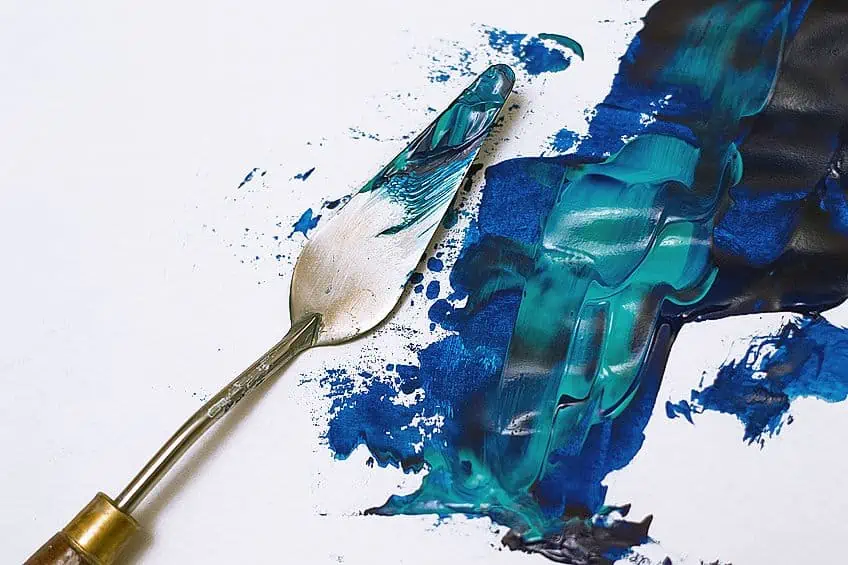
Creating Muted Shades of Blue
Most painters hardly ever use blue directly from the tubes, so they spend a lot of time mixing muted blue colors, or blue that is dull or has a low saturation. So, let us now learn how to create different muted shades of blue. When it comes to making muted colors, then complementary colors play a vital role.
What is a complementary color? These colors lay on opposite ends of the color wheel. The color wheel shows that yellow lies directly opposite to purple, this makes them complementary colors. In the same way, that blue is transversely situated from orange. Since blue and orange are both complementary colors, by mixing them, you create a muted shade of blue.
When taking ultramarine blue and mixing it with cadmium orange, it tends to take away the brightness in the blue color, making it slightly duller. This essentially makes the blue less blue, giving you a rich muted blue color. However, be very careful not to overdo the orange, as you will then end up with a color leaning towards green. When mixing burnt umber with ultramarine blue or cobalt blue, you will create a brownish tint of blue, which will help you when you want to use a more muted brownish form.
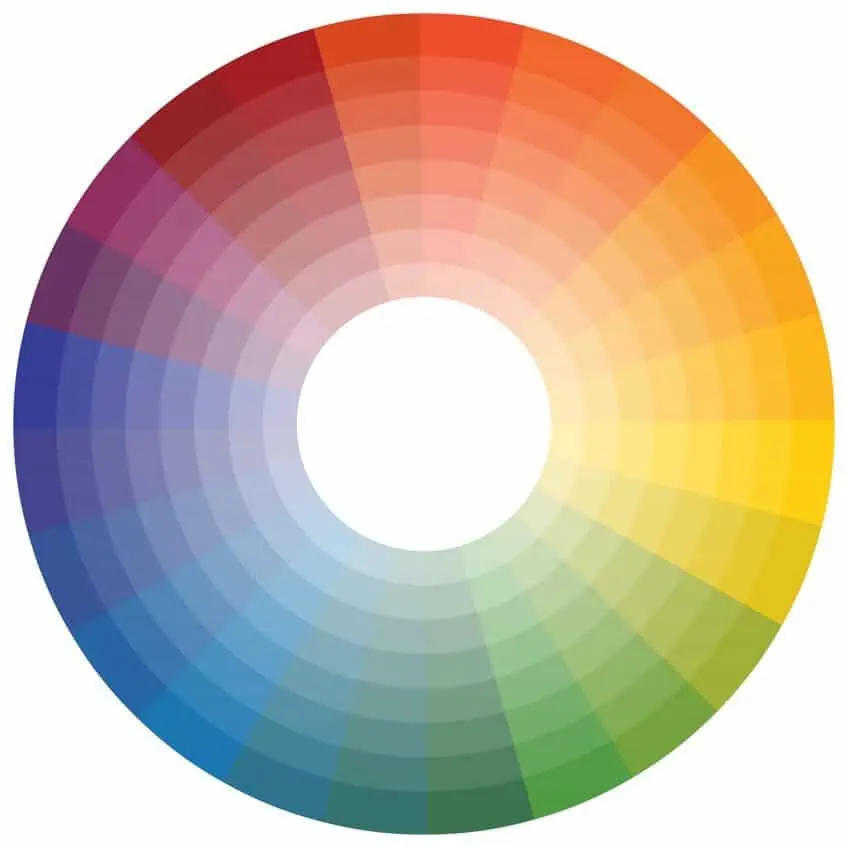
How to Create Warm Shades of Blue?
We are all aware that temperature plays an important role when it comes to colors. Seeing that blue is regarded as a cool color, it is, therefore, possible for us to mix warm shades with blue colors. Ultramarine blue is indeed a warm color on its own, but at times you may need a warmer blue color. This is where you can mix ultramarine with alizarin crimson, creating a much warmer blue color.
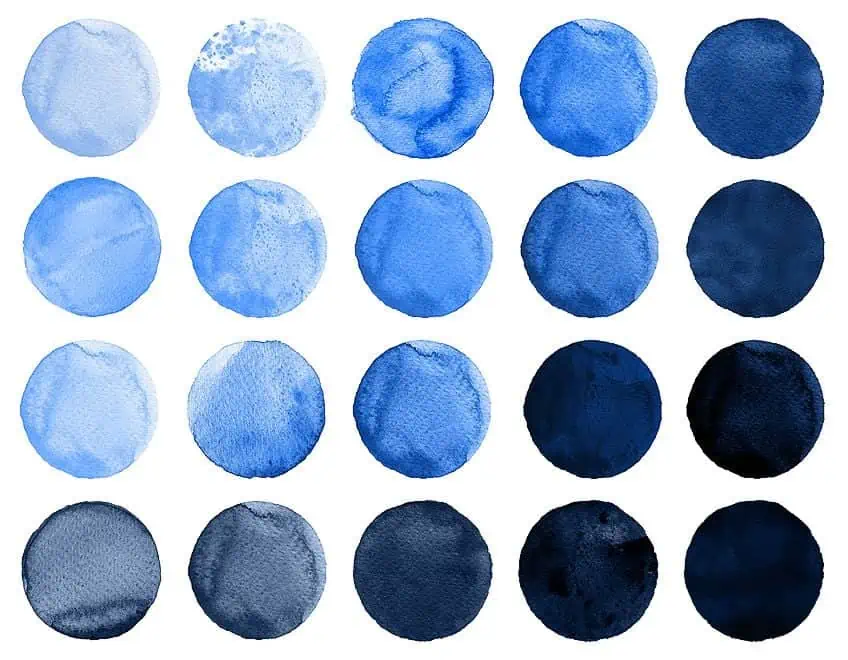
You can also take cadmium green and mix it with cobalt blue, creating a warm blue shade. This warm color may not be as warm as when mixed with alizarin crimson, but it does give you a blue shade that is warmer. Now, if you use cobalt blue which is regarded as cooler than ultramarine blue, with the same combinations as seen above, your blue created will not be as warm as when you use ultramarine blue.
How to Create Turquoise Blue Colors?
Turquoise is often seen in paintings representing the ocean or the sky. In many cases, the color almost appears to have a bit of yellow in it, which can only be created if you make use of a little green with the blue.
When you mix ultramarine blue or cobalt blue with cadmium green, you create a blue that has a shade of turquoise. If you add a bit of white to this mixture, you end up with a lighter blue that resembles the true color of turquoise.
By mixing ultramarine blue or cobalt blue with veronese green, which is a bright cool green, you create a fascinating turquoise blue. This shade of turquoise blue retains much of its original blue color, making it a very rich color. If you add a bit of white to this mixture, you end up with a light turquoise blue that retains its brilliance.
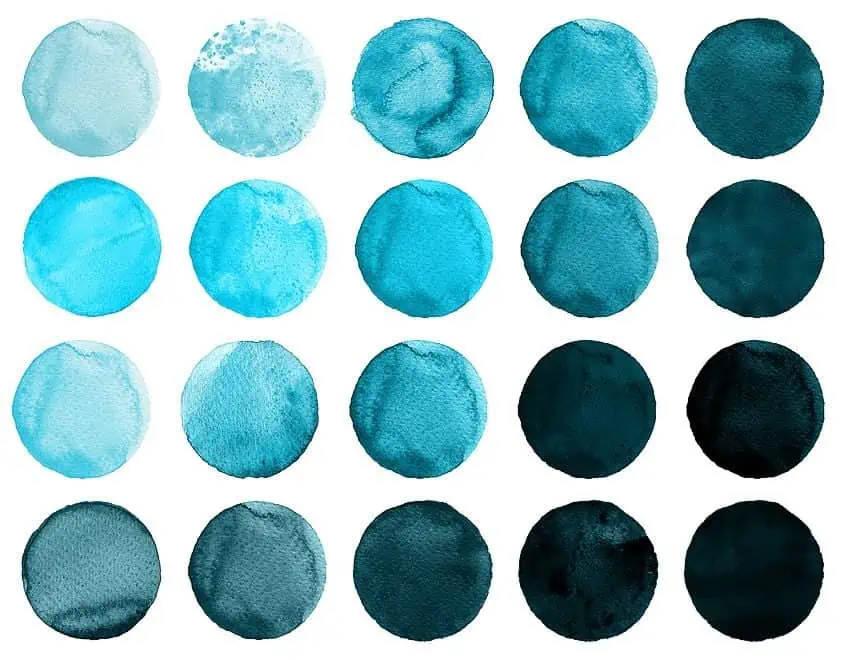
Psychology of the Color Blue
All the colors portrayed in the rainbow are beautiful, but the color of blue seems to catch your eye with its beautiful rich tone. The color seems to stir up feelings of peace, tranquility, and calmness. Yet, the color blue can also invoke an icy cold look and feel, and immediately arouses your alertness. All human beings are attracted to the color blue in some way or another, whether it is gazing up into the clear blue sky or looking into pools of sparkling, freshwater.
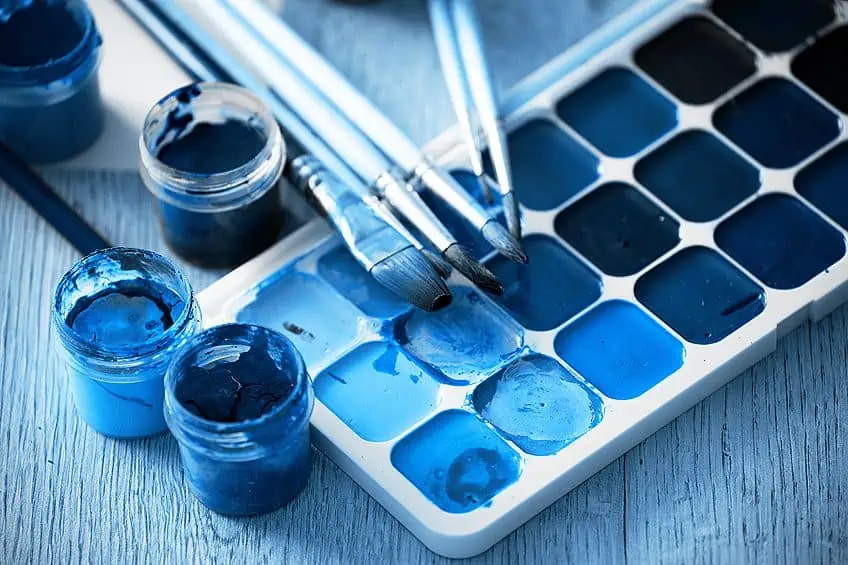
So, how does blue make you feel? Humans through the ages have believed that certain colors arouse various kinds of moods. Research shows that various colors can prompt certain emotions. However, blue is one of those colors that form part of nature in the sky or the water, which may be the reason why many feel the color blue has a calming effect on them. Let us now look at how the color blue can affect your moods and feelings. The study and psychology of the color blue can indicate the following.
- Many describe the color blue as being the most liked color by men
- Blue is seen as a benign color
- The color blue has been found to have a calming effect and has been identified as tranquil, orderly, serene, and peaceful
- The color is also considered a symbol of reliability and stability, which is why some businesses use blue in their marketing and advertising strategies
- However, blue can also create feelings of sadness, which is very clearly portrayed by Picasso in his paintings during his 'blue period,' which gives you a feeling of sadness and loneliness
- Many businesses have painted their office blue because it has been said to make people more productive
- Even the color blue is very popular, it is also the least enticing or appealing color. This is why many of the plans for weight loss encourage you to eat from a blue plate, as it only occurs in nature in the form of berries and plums. We are all encouraged to avoid any foods that are regarded as poisonous, and food that has blue coloring in it is a sure sign of spoilt or poisonous food
- Research has shown that blue can lower your pulse rate and even your temperature
- Lastly, the color blue is used very often in our conversations like 'Blue Monday', 'Blue Moon', 'Blue Ribbon', 'The Blues' and 'Blue Blood'.
Differences between Various Shades of Blue
As you explore the color blue, you will soon discover that each shade or tint has its characteristics. Below you will find a table that makes this a lot easier to follow and understand. For this example, we have only taken three of the best-known colors of blue.
| Source of Comparison | Navy | Cobalt | Royal |
| Description | Navy Blue: darker shade of blue which is almost black | Cobalt Blue: rich medium gray-blue shade | Royal Blue: deep blue shade and is often with traces of purple or red |
| Correlation | Navy Blue has its association with the navy and the military for centuries | Cobalt Blue has been a popular color used by businesses for a long time | Royal Blue has its association with royal families for centuries |
| Signifies | Duty, official, confidence, and authority | Trust and reliability | Excellence, honesty, royalty, and fidelity |
| Hex Code | #000080 | #0047ab | #4169e1 |
| Brightness | Low intensity | Medium intensity | High Intensity |
| Psychological Effect | Commanding and authoritative Influence | Calming and serene influence | Calming effect or Influence |
| Status | Common in major international countries | Common throughout the world | Common throughout the world |
| Use | Navy Blue is used for office and household interiors, a popular color for pillows and sheets, and robes for traditional leaders and monks in Africa | Cobalt Blue is popular for school uniforms and dresses, television graphics and ceramics, and glassware | Royal Blue is used for interiors and is also common for restaurant menus, logos, and interiors |
| Blending | Navy Blue is often blended with different shades of orange, green, purple, and yellow | Cobalt Blue is often blende with purple, maroon, white, and burgundy | Royal Blue is often blended with white, green, gray, purple, gold, and red |
What Colors Make Dark Blue Paint?
When you create a dark blue color, take your blue, and mix it with another color. There are several different colors you can add that will make your blue darker. Learning how you can mix colors will increase your options and will provide you with the perfect blue shade. Let us have a look at some of these options.

Making Dark Blue Color by Adding Black Paint
Take your palette or a paper plate and place an ample amount of blue paint onto the surface, enough to finish your project. You need to make sure that the amount of blue paint will be enough to cover what you need because it is difficult to try and match the same shade of dark blue paint a second time. If you make too much paint, it is no problem, as you can store the excess paint in a plastic container. Take a sponge or paper towel, wet it, and place it under your palette or paper plate to prevent your paint from drying out while you are busy painting.
Now put a very small amount of black paint right next to your blue paint on the palette or paper plate. Make sure you put the black paint next to the blue paint and not directly on top of it, which will allow you to add small amounts of black paint each time, giving you greater control over the dark blue shade you are creating.

Take your paintbrush and gently dip it into the black paint and drag only a small amount over to your blue paint, as black is a very strong color and will have a significant effect on your blue. Next, fold the colors making use of a mixing tool or your paintbrush, and at this stage, do not mix it thoroughly as it will make your color dull. Mix just enough to be able to assess the shade of dark blue you are creating.
You can now add more black paint, a little at a time until you are satisfied with the dark blue color. You can repeat this process over and over again by only adding small amounts each time. However, if you find you have added too much black, take some extra blue paint and even the ratio out.
Making Dark Blue Color by Adding Complementary Paint Colors
The first step is to print out a copy of the color wheel. When choosing which color wheel to print out, rather choose a tertiary color wheel that has 12 colors that include various shades, hues, and tints. Apply some of the original blue paint to a piece of white paper and allow it to dry. Now compare that color with the color on your color wheel and make an accurate match.
Next, you need to identify the shade of orange that is opposite and complementary to the shade of blue you identified. This will be the color orange that you will be mixing with your blue to darken it. Some examples of this are mixing ultramarine blue with burnt sienna or cobalt blue with cadmium orange.
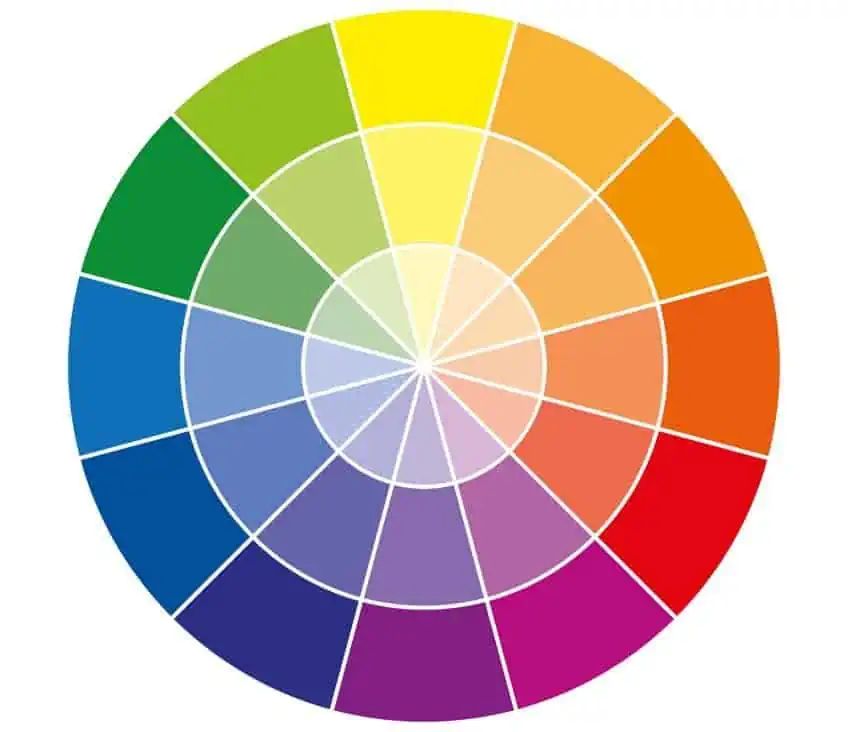
Take your palette or paper plate and squeeze out just enough blue paint required to complete the dark shade of blue. Now add some of the orange next to and not on top of the blue paint, you will only need a small amount of the orange paint so add it carefully. Drag a very small amount of the orange into the blue paint making sure it is not too much, and then keep adding a small amount each time until you are satisfied with the color.
Little by little fold the orange paint into the blue using your paintbrush or a palette knife. By making use of complementary colors, you will be able to create a brilliant shade of dark blue. Try not to do too much mixing, as this will dull the paint color. Again, if you have accidentally mixed too much of the orange paint, add some extra blue paint to even out the ratio.
Making Dark Blue Color by Adding Analogous Paint Colors
Take your palette or paper plate and squeeze out some blue paint, and then squeeze out some purple paint next to the blue paint. Purple or violet are both analogous colors as they are found adjacent to blue on the color wheel. Ensure you have plenty of paint to finish your entire painting. Make sure that you have more blue paint as a base color than purple paint.
Now mix a very small amount of the purple paint with your base blue color by making use of your paintbrush or a palette knife. Continue this process by adding a very small amount of purple paint so that you can control your color combination and create your violet-blue color.
You can now test your combination paint color. Take a small amount of your new color and paint it onto your canvas and give it time to dry. This should only take around 15 minutes. This will give you the true color of the blended combination that you will be using on your project. Remember, most types of paint including acrylic paints, will get a darker shade when they dry. If the color you tested is not exactly what you wanted, then go back and add some more purple or black until you are completely satisfied.
Tips When Mixing Different Shades of Blue
There are hosts of options available when you want to create different shades of blue, centered on how you want light and shadows to appear in your work. There are a few simple tricks that will help you to achieve the exact blue tone you want without making mistakes along the way. We will be sharing these with you below.

If you want to make the blue appear deeper, then you need to add some gray or black. To make the color lighter, you need to add some white. Do not overdo it when you are adding extra colors, but just add a small dab of paint, so you can see the effect it has on your painting. Here are a few simple rules to follow when you are creating different shades of blue:
- When you add red to your blue, you will get a closer match to purple
- The medium you use will affect the ratios you need to get the correct color you want, based on issues such as texture and absorption
- When you add yellow to your blue paint, you will get a closer match to green
You will soon learn that learning how to make blue can only be perfected by practicing and experimenting. Once you have selected the colors you will use to create your perfect color, be careful, as blending too much of the paint will cause your color to become dull. A perfect mix will bring out all of the characteristics of your original blue base color.
Conclusion
Bear in mind that the ratios you use to create your different shades of blue will depend largely on the materials you are using. For example, if you want to create a particular shade of blue and you are using acrylic paints, the ratio of colors will be different than if you are working with watercolors. This is because watercolors blend quicker and more thoroughly than other more solid paints. The heart of the matter is that the color blue, as a primary color, can be made into any shade of blue you want, as long as you start by using cyan and magenta.

Frequently Asked Questions
What Color Will Dark Forest and Ocean Blue Make?
Both of these colors when mixed properly together should give you a dark green color. However, if you are not careful and you mix too much of each color you will not get a dark green color. Some good advice is that you first start with the lighter color and then you slowly add the darker color until you are satisfied with the shade you wanted to create.
Can I make Green without Using Blue?
You can add a little bit of yellow paint to the black paint, and if you want a lighter color green you can always add some white paint. However, this is not an ideal solution as it is far better to use blue paint if you want to create green color paint. But if you do not have any blue paint available, then mixing yellow, black, and white paint will do the trick.
To Make Dark Blue Paint, Can I add Black or Combine Other Colors?
By adding black paint to your blue paint, you will create a dark blue color. However, you can also blend orange, or purple to give you the same result. So, you can try following both methods to see which one works best for you.
How to Make Blue Paint with Orange?
The answer is no, it will make an orange color, but you can then use the orange color and mix it with blue. This will then create a dark blue color.
When Blending Black with Ice Blue What Color Will I Create?
Depending on the amount you use of each color, you may create anything from blue-black to grey-blue.
How to Make Blue Lighter?
If you want to make a blue or any other color lighter, all you need to do is add some white. However, be careful to add the white paint in small amounts each time. When you are blending colors, always start with the lighter color and then add the darker color in small amounts.
What Color Can I use with Brilliant Blue to Make Dark Sea Blue?
You can add black, but make sure you only add an extremely small amount each time. You may also need to add a little green to reach the dark sea blue. Remember, experimenting and documenting your finds is important for future painting projects.
Source: https://acrylgiessen.com/en/what-colors-make-blue/
0 Response to "What Color Do U Get if U Mix Pink and Blue"
Post a Comment